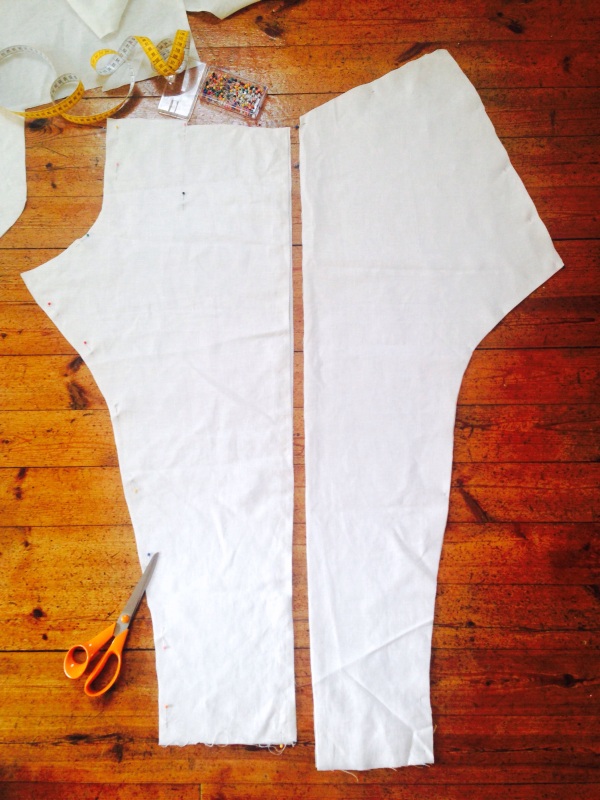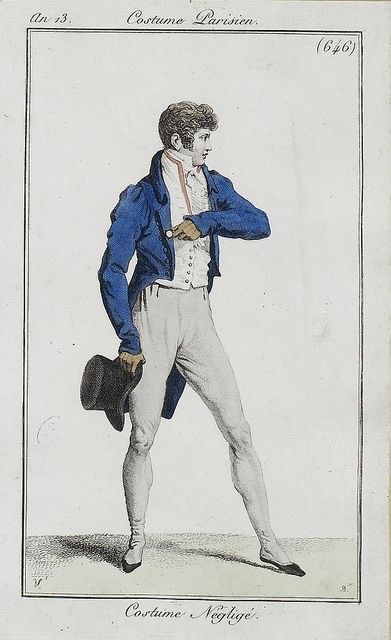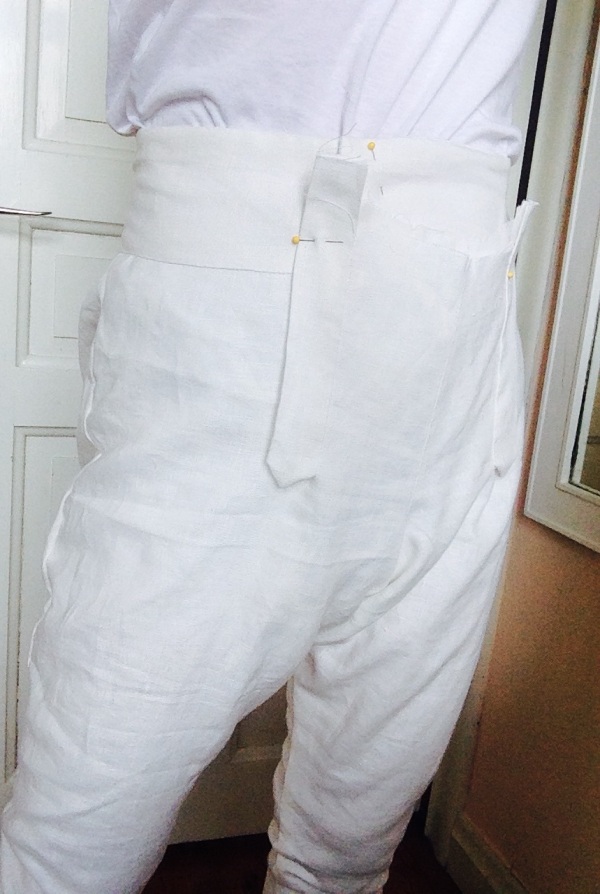Only one week to go before the glorius Stockholm Empire Days of 2016! My summer was oh so busy, going places, so I had no plans to make anything new this year. Before the summer I made the striped waistcoat that hasn´t yet been out in public, and I could have settled with that. But then I thought: Why not make pair of breezy linen trousers for one of the picnics? The decision was made the moment I found some perfect linen in the stash. Luckily there was (just) enough of it.

Cutting the required pieces. I measured my legs and googled patterns on Regency trousers for a quick reference.

Marking where to cut the front fall. (The two vertical pins, top centre.)
Trousers came in all shapes during the Regency, from very loose fitting ones to the extremely tailored pantaloons that hugged one’s legs like a second skin. They could be made in cotton, wool, linen, or stretchy knitted material. Sometimes these different types of trousers and pantaloons were very long. They could have straps that went under the shoe to keep the fabric stretched. Sometimes they ended somewhere mid-calf. Sometimes they were really full around the waist (“cosacks”). And let us not forget that breeches were still very common, not only for formal attire.

1806: Very long pantaloons disappearing into the shoes.

Again 1806, but these trousers, and the ones below, are ankle lenght.


1800: These nankeen pantaloons are very tight. It looks like one of those Incroyables and we won´t go there. (Well at least not this time!)

Linen pantaloons, The Metropolitan Museum.

First fitting. Trying out the legs. How tight dare I go?

Stitching centre back seam. Then I removed the orange basting.

Then I realised the linen was revealing so I rustled up some gauzy cotton to line the entire garment.

This is where the self-covered buttons will go. The fall and fall bearers are nearly done.

The back is gathered to the waistband. Adjustable tape at centre back.

And the back looks like this when wearing the pantaloons.

Very baggy seat compared to the legs. So different from modern trousers!

Without all that extra material it wouldn´t be possible to do this, since the fabric hugs the calves.

The front and thighs are relatively smooth, but not tight. The fall edge needs to be finished, but I wanted to make sure it is going high enough.

This is going to be one snappy pair of pantaloons. 🙂
Need I say how flattered I am that the Frock Flicks team mentioned my previous post? As a long time follower I have the deepest respect for their work. Imagine that they actually took time to read this modest blog…
Love this post! Thank you so much.
My pleasure!
Nicely done, Mr. Elton. I particularly admire your buttons.
Thank you, my dear!
Very awesome post! So interesting to see the steps in making them and why things for the way they did.
Thank you! Yes, a piece of clothing is a product of its day. Many times it is a question of fashion trends but with this project I get a bigger understanding for why they did what they did: The baggy bottom is necessary for mobility and it is hidden by the tailcoat anyway… (On the other hand satin breeches for a formal ceremony of some sort that only required the wearer to walk and stand could be extremely fitted.)
I stumbled across your blog while looking up what kino dye looked like on cotton. It described “nankeen” but being the artist I am, I wanted to see what period pieces looked like and their specific type of color. After I saw you were constructing period clothing, I had to see your process. Although I’m not a seamstress, I have also copied/reconstructed a tiny few period pieces (but those were for infants and small girls). I enjoyed seeing your creative process. Thanks for having such an interesting blog!
Terrific! Thank you!
/Mr E
Pingback: The Empire days of 2016 | Regencygentleman
Nice, makes me more comfortable about dressing my husband if we can find a Regency dance group inside feasible driving distance
Great! I find it less nervous to look for good but cheaper fabrics (thrift stores!) when starting out.
Necessary now my haberdashery has shut down….. 😦
Oh, no. Sad when that happens, but I hope you’ll manage anyway!
Hello,
If I were to order pantaloons from a tailor identical to the ones in this article, how would I go about ? Do you have patrons that could be used ? detailed instructions ?
Thank you !
Greg
Hello Greg, thank you for commenting. I drafted the pattern and the design to fit me, so it isn’t commercially available. I’m sure that an expert in Regency fashions, such as Zach Pinsent at Pinsenttailoring, would be able to help you with a pair of pantaloons similar to the ones in this post. Was this helpful enough…?
I’m in Paris – do you know anyone here ?
You’re obviously skipping so many steps in the way you assembled this item, and you must have advanced sewing experience.
Looking at those pantaloons they appear quite modern. With a modern sport coat covering the loose seat they could appear as tight/slim fit modern pants. But then you would have this unusual high rise, which was naturally covered by the waistcoat, sort of a as cover or a top that would make the bottom flow, or transition, into the upper body segment. It all seems so logical. If you were to wear them with a modern sport coat I would think the jacket would always have to be buttoned.
Sorry for late reply! I can’t help you regarding Parisian tailors. My posts are meant more as inspiration rather than detailed tutorials. I wore these pantaloons once with a big shirt for a (non-historical) summer event.
Hey, this is amazingly useful.
I’m learning how to sew and my teacher told us we have to make a trouser so I saw one similar to this one and I really wanted to try making it, but there’s a detail that I do not finish to understand, and it is the covered buttons part.
I’m still not sure how to make it, so, if you can explain me how to do it or where can I find a tutorial I can follow, I will be eternally grateful. 🤗💜
Hello! This is probably too late, but the easiest method is to buy a kit at the fabric store – the metal button base easy and makes a nice fabric covered button. With these pantaloons I just covered ordinary buttons, which in a way is less complicated but sldo more fiddly.
Thank you for this post, it is most informative, and helpful, as I am currently making a new pair of trousers/pantaloons for my husband.